Speaking up for Palestine
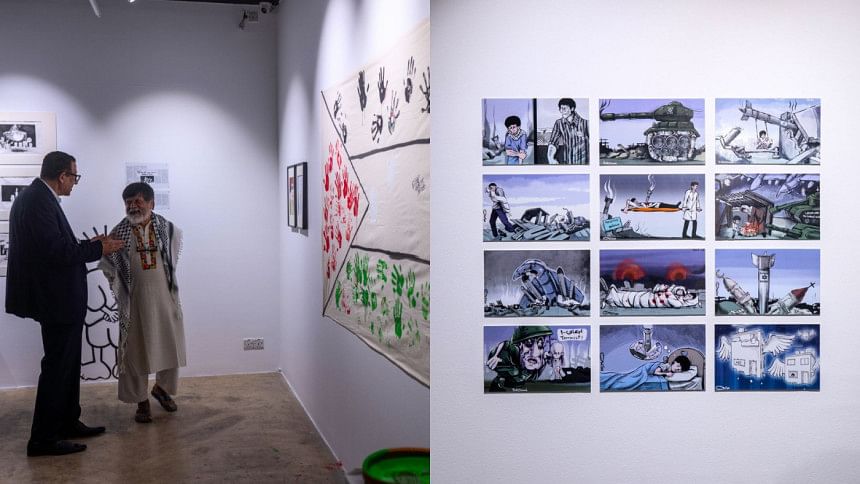
Yesterday, during a brief respite amid local political unrest, artists and activists gathered at the Drik Gallery to participate in a cartoon exhibition organised in protest of the brutal Israeli occupation and ongoing genocide in Gaza. The history of violence and displacement against the Palestinians spans 75 years, taking a merciless turn last month.

It is estimated that nearly 11,000 Palestinians have been killed due to the incessant bombing perpetrated by the Israeli government. People in the eastern hemisphere and around the world have raised their voices hoarse with protests, calling for a ceasefire.


Commencing yesterday at 5 pm, cartoonists and young artists from Dhaka gathered at Drik Gallery with cartoons and installation art, protesting the Israeli occupation and expressing solidarity with the Palestinian people.

Present at the event were the Palestinian Ambassador to Bangladesh Yousef SY Ramadan, decorated cartoonist Ahsan Habib, Joint Secretary of Bangladesh Cartoonist's Association and artist Mehedi Haque, Photographer and Drik Managing Director Shahidul Alam, and Documentary Photographer and ASM Rezaur Rahman, who is also the curator of the exhibition.

Comprising collages, graffiti, installation art, and cartoons, the exhibition will run until November 14, from 3 pm to 8 pm.

The exhibition witnessed a steady stream of both young and old cartoonists, all gathered to show their support for the Palestinian people. What we see or read in the news is vastly different from what is happening on the ground or what is felt when we see someone affected by it. That is what I learned from Yousef SY Ramadan's speech, where, along with expressing his heartfelt gratitude to the audiences, the ambassador also shared that he had recently been informed of the loss of 54 family members.


That is horror beyond comprehension and thus requires recognition to be denounced. The entire exhibition featured cartoons and representations of the cruelty inflicted by the Zionist state on Palestinians, which began long before. Along with local artists, the gallery walls were graced by legendary Palestinian artist Naji Al Aji and Mohammad Sabaaneh.


"It has long been debated whether artists are activists, where I think art itself is an activism," said Mehedi Haque. "Art carries a personal touch, a human element that leaves a mark. Many things we hear or read can be easily forgotten, but a group of people gathered under the banner of art, in solidarity, in protest, will leave a visual to be remembered." Similar sentiments were echoed by eminent cartoonist Ahsan Habib, who believes that people remember things longer when said humorously.


"There are layers to humor and cartoons, like irony, satire, lampoon, and whatnot. That's the thing about cartoons; a lot of problems that cannot be addressed directly, cartoons convey in passive ways. But with humor, people remember funny things," he replied.

The idea behind the exhibition was a unique one, expressed by Mehedi Haque, who had been contacted by fellow artist Mohammad Sabaaneh to submit cartoons against the Palestinian genocide. Mehedi, however, decided that instead of sending one, he could send many and compiled works from both senior and young artists.


"When we illustrate the situation, we inspire a lot of people. I believe that many people who visit the exhibition will be inspired to protest and speak out in their own ways," said Mehedi, who hopes that the younger generation visiting will keep the protesting voices for the Palestinian people loud enough to be heard.

Art not only functions as a medium of expression but also as a binder that ties people and revolutions together. One corner of the gallery featured the legendary character Handala, the little boy with his back turned to the world, who became the personification of Palestinian resistance and nationalism, along with multiple displays of cartoons by Naji Al Ali. A prolific cartoonist of the Arab world, Naji Al Ali was brutally assassinated in 1987, allegedly for his political criticism of the Arab regime and Israel.


Amongst the installation arts, the paper-mache watermelon stood proudly among the canvases, bearing testament to the endurance of the Palestinians who used the fruit as a nationalist symbol when waving the Palestinian flag had been outlawed.


Amongst traditional and new media, one thing remains evident: the outspoken criticism of the Zionist state of Israel and the brutalism they inflicted on the Palestinian people. While the whole world is already in rallies and gatherings of millions calling for a ceasefire, the sentiment remains the same among all, regardless of the medium.

While the question might arise, what can art possibly do? We should also do well to remember that people gather at the sight of posters; it is art that speaks when words cannot.
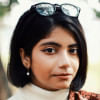
 For all latest news, follow The Daily Star's Google News channel.
For all latest news, follow The Daily Star's Google News channel. 

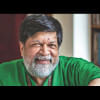
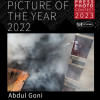
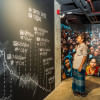
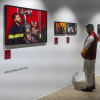
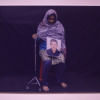


Comments